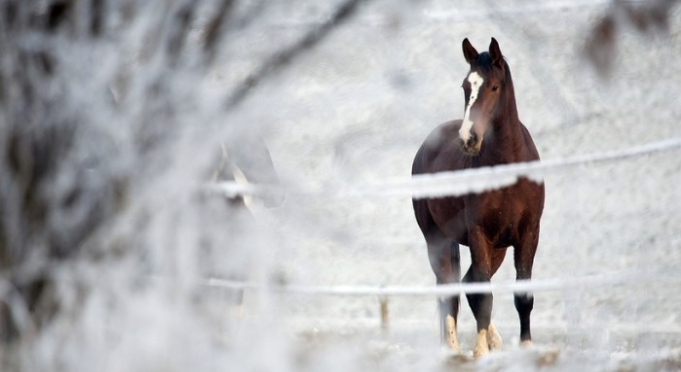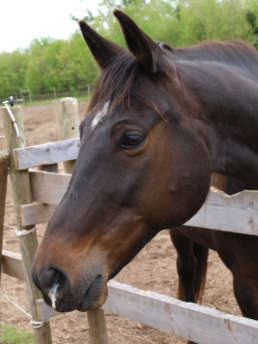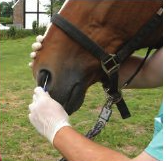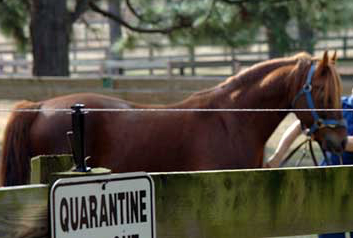
March 2018
Equine Influenza (H3N8) Diagnosed in Kansas
By Elizabeth Perry, DVM

|
|
Photo source
|
Kansas State University's Veterinary Diagnostic Laboratory has recently confirmed equine influenza virus (EIV) cases here in Kansas. Influenza virus is an orthomyxovirus which is further classified into strains by the surface proteins found on the virus - this is where the "H" and "N" come into play that you commonly hear about. The strain affecting horses is called H3N8 and this is a highly contagious virus that can rapidly spread. Most of the world, including the United States, is endemic with equine influenza, so it is not surprising that horses have tested positive with EIV here in Kansas. In order that we keep horses healthy, is important for equine enthusiasts to know the clinical signs, management strategies and how to prevent the spread and infection of EIV.
What to look for in your horse:

|
|
Photo source
|
Under the microscope:
Let's take a look at a deeper level to understand what exactly is going on during this disease process. Once the virus enters the respiratory tract it is able to replicate within the cellular lining. The virus kills these cells which causes inflammation and impairs the natural clearing ability. Secondary bacterial infections may develop which can lead to worsening clinical signs as well as bronchopneumonia, pleuritis and even death. It is important to note that the classic clear-watery nasal discharge will change to a thick green-yellow character in the presence of a secondary bacterial infection. Younger horses (ages 1-5) tend to be most frequently infected. Healthy horses should be able to clear the infection themselves with rest and supportive care. Horses with a suppressed or weakened immune system are at higher risk of developing a more severe form of the disease and may need more intensive therapy.
Is this the Flu?

|
| Photo source |
Prevention is key:
The most important topic of discussion on EIV is prevention. Using a multi-pronged approach to disease prevention will help keep the majority of horses healthy. The combination of effective biosecurity, implementation of optimal vaccine strategies that induce herd immunity along with overall ideal host health will help reduce the frequency of infectious disease. Biosecurity involves evaluation of horses that enter a property to ensure health status. Restriction of contact for a minimum of two weeks will allow for a period of observation for any potential disease development. If a horse is showing the clinical signs of disease, they should be placed into isolation while monitoring the rest of the herd. Temperatures should be checked twice daily and contact your veterinarian if a temperature over 101.5 oF is identified.

|
| Photo source |
Using this approach of careful introduction of new horses or those that have been in contact with outside horses will reduce the likelihood for spread of infectious disease. Horses can be protected at the individual level by vaccination. The American Association of Equine Practitioners (AAEP, www.aaep.org) recommends initial priming vaccines with a protocol that is dictated by age, working with your veterinarian you will be able to determine the ideal protocol for your horse(s). In general, horses less than a year of age receive an initial series of three vaccines while adult horses receive a priming protocol that includes two vaccines. Once the initial priming series is complete booster vaccines are administered once or twice annually, depending on risk of exposure to EIV. Vaccine may be administered during an outbreak to help enhance the horses' immunity against EIV. Working with your veterinarian will enable you to develop and optimal vaccine protocol for your horse.
In summary:
While EIV can be a serious disease, it is important to remember that this virus has been around for a very long time and can be found worldwide. When infection occurs, most horses recover within two to three weeks. Following recommended vaccine protocols, implementing effective biosecurity strategies that include placing new arrivals in quarantine and isolating affected horses will help prevent the spread of EIV. If you horse is demonstrating the clinical signs consistent with EIV contact your veterinarian early and together you will be able to create a treatment, preventative and monitoring program that fits your horses' needs. An excellent information source for becoming aware of outbreaks as well as learning about different diseases is the Equine Disease Communication Center (http://www.equinediseasecc.org). As always, please do not hesitate to contact our veterinarians here at the KSU-VHC with any questions that you may have.
While EIV can be a serious disease, it is important to remember that this virus has been around for a very long time and can be found worldwide. When infection occurs, most horses recover within two to three weeks. Following recommended vaccine protocols, implementing effective biosecurity strategies that include placing new arrivals in quarantine and isolating affected horses will help prevent the spread of EIV. If you horse is demonstrating the clinical signs consistent with EIV contact your veterinarian early and together you will be able to create a treatment, preventative and monitoring program that fits your horses' needs. An excellent information source for becoming aware of outbreaks as well as learning about different diseases is the Equine Disease Communication Center (http://www.equinediseasecc.org). As always, please do not hesitate to contact our veterinarians here at the KSU-VHC with any questions that you may have.